Detailed Analysis of Re Baden's Deed Trusts in Trust Law
VerifiedAdded on 2020/04/29
|12
|3115
|308
Essay
AI Summary
This essay provides a detailed analysis of the case of Re Baden’s Deed Trusts (No 2), focusing on the key principles of trust law, particularly the certainty of objects in discretionary trusts. The essay begins with an introduction to trusts as a business structure, highlighting the roles of trustees and beneficiaries, and the significance of trust deeds. It then delves into the specifics of Re Baden’s Deed Trusts, discussing the facts of the case and the court's application of the 'is or is not' test established in McPhail v Doulton. The essay examines the different approaches taken by the judges, including Stamp LJ, Sachs LJ, and Megaw LJ, in interpreting and applying the certainty of objects test. A critical analysis is provided, comparing and contrasting the judges' interpretations and assessing their practical implications. The essay concludes by evaluating the best approach for trustees, arguing in favor of Sachs LJ's pragmatic and sensible approach, which balances conceptual certainty with evidential considerations. The essay highlights the importance of burden of proof and the challenges in identifying beneficiaries, offering a comprehensive understanding of trust law principles.
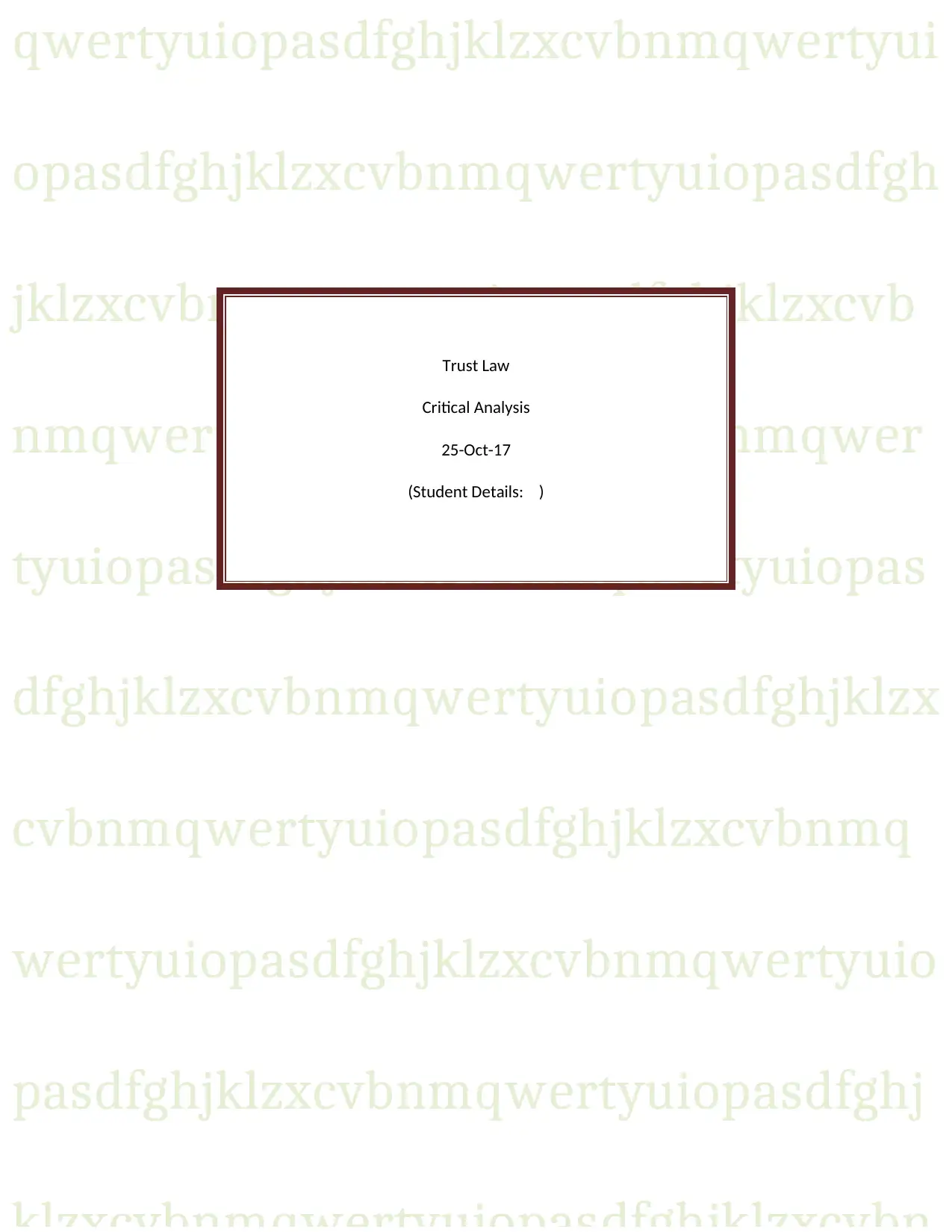
qwertyuiopasdfghjklzxcvbnmqwertyui
opasdfghjklzxcvbnmqwertyuiopasdfgh
jklzxcvbnmqwertyuiopasdfghjklzxcvb
nmqwertyuiopasdfghjklzxcvbnmqwer
tyuiopasdfghjklzxcvbnmqwertyuiopas
dfghjklzxcvbnmqwertyuiopasdfghjklzx
cvbnmqwertyuiopasdfghjklzxcvbnmq
wertyuiopasdfghjklzxcvbnmqwertyuio
pasdfghjklzxcvbnmqwertyuiopasdfghj
Trust Law
Critical Analysis
25-Oct-17
(Student Details: )
opasdfghjklzxcvbnmqwertyuiopasdfgh
jklzxcvbnmqwertyuiopasdfghjklzxcvb
nmqwertyuiopasdfghjklzxcvbnmqwer
tyuiopasdfghjklzxcvbnmqwertyuiopas
dfghjklzxcvbnmqwertyuiopasdfghjklzx
cvbnmqwertyuiopasdfghjklzxcvbnmq
wertyuiopasdfghjklzxcvbnmqwertyuio
pasdfghjklzxcvbnmqwertyuiopasdfghj
Trust Law
Critical Analysis
25-Oct-17
(Student Details: )
Paraphrase This Document
Need a fresh take? Get an instant paraphrase of this document with our AI Paraphraser
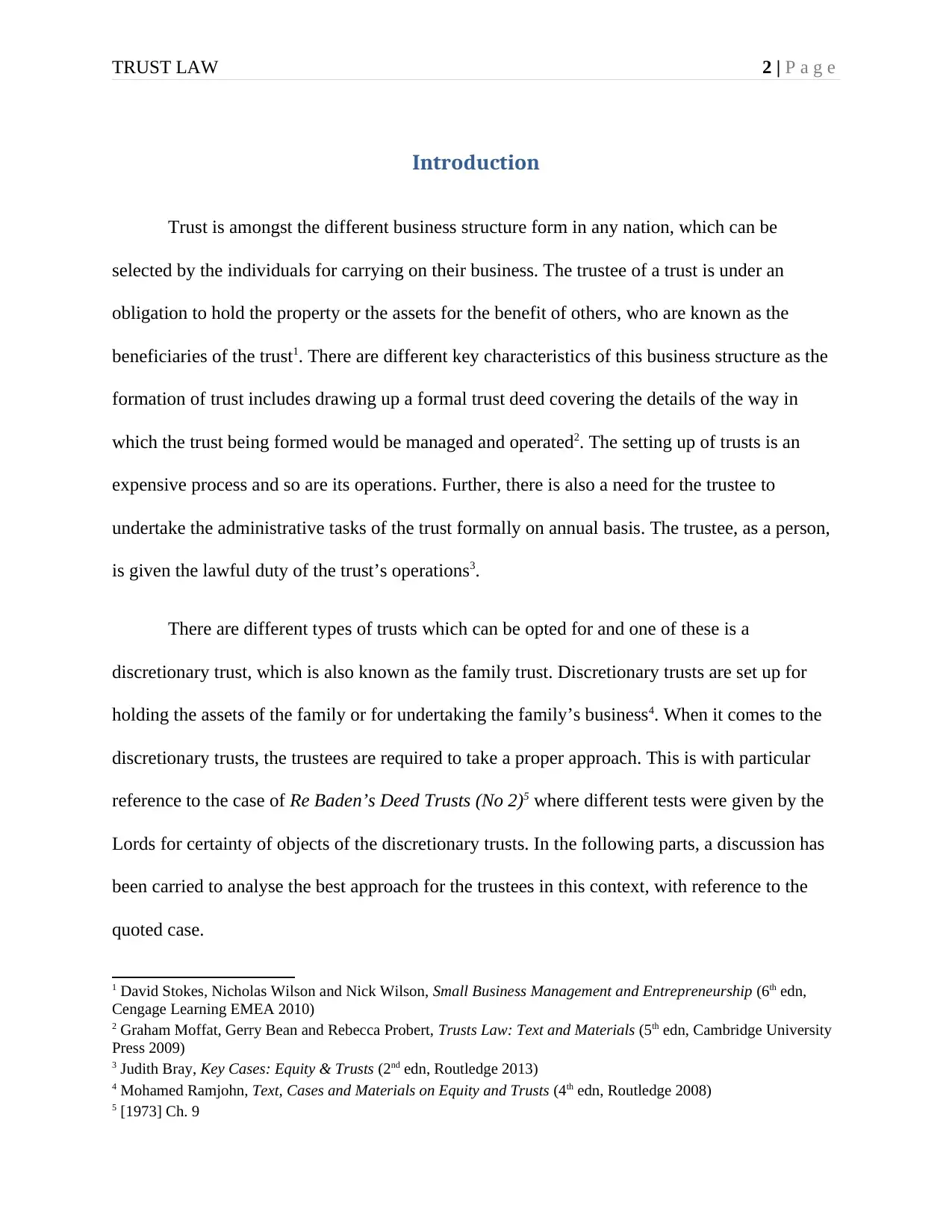
TRUST LAW 2 | P a g e
Introduction
Trust is amongst the different business structure form in any nation, which can be
selected by the individuals for carrying on their business. The trustee of a trust is under an
obligation to hold the property or the assets for the benefit of others, who are known as the
beneficiaries of the trust1. There are different key characteristics of this business structure as the
formation of trust includes drawing up a formal trust deed covering the details of the way in
which the trust being formed would be managed and operated2. The setting up of trusts is an
expensive process and so are its operations. Further, there is also a need for the trustee to
undertake the administrative tasks of the trust formally on annual basis. The trustee, as a person,
is given the lawful duty of the trust’s operations3.
There are different types of trusts which can be opted for and one of these is a
discretionary trust, which is also known as the family trust. Discretionary trusts are set up for
holding the assets of the family or for undertaking the family’s business4. When it comes to the
discretionary trusts, the trustees are required to take a proper approach. This is with particular
reference to the case of Re Baden’s Deed Trusts (No 2)5 where different tests were given by the
Lords for certainty of objects of the discretionary trusts. In the following parts, a discussion has
been carried to analyse the best approach for the trustees in this context, with reference to the
quoted case.
1 David Stokes, Nicholas Wilson and Nick Wilson, Small Business Management and Entrepreneurship (6th edn,
Cengage Learning EMEA 2010)
2 Graham Moffat, Gerry Bean and Rebecca Probert, Trusts Law: Text and Materials (5th edn, Cambridge University
Press 2009)
3 Judith Bray, Key Cases: Equity & Trusts (2nd edn, Routledge 2013)
4 Mohamed Ramjohn, Text, Cases and Materials on Equity and Trusts (4th edn, Routledge 2008)
5 [1973] Ch. 9
Introduction
Trust is amongst the different business structure form in any nation, which can be
selected by the individuals for carrying on their business. The trustee of a trust is under an
obligation to hold the property or the assets for the benefit of others, who are known as the
beneficiaries of the trust1. There are different key characteristics of this business structure as the
formation of trust includes drawing up a formal trust deed covering the details of the way in
which the trust being formed would be managed and operated2. The setting up of trusts is an
expensive process and so are its operations. Further, there is also a need for the trustee to
undertake the administrative tasks of the trust formally on annual basis. The trustee, as a person,
is given the lawful duty of the trust’s operations3.
There are different types of trusts which can be opted for and one of these is a
discretionary trust, which is also known as the family trust. Discretionary trusts are set up for
holding the assets of the family or for undertaking the family’s business4. When it comes to the
discretionary trusts, the trustees are required to take a proper approach. This is with particular
reference to the case of Re Baden’s Deed Trusts (No 2)5 where different tests were given by the
Lords for certainty of objects of the discretionary trusts. In the following parts, a discussion has
been carried to analyse the best approach for the trustees in this context, with reference to the
quoted case.
1 David Stokes, Nicholas Wilson and Nick Wilson, Small Business Management and Entrepreneurship (6th edn,
Cengage Learning EMEA 2010)
2 Graham Moffat, Gerry Bean and Rebecca Probert, Trusts Law: Text and Materials (5th edn, Cambridge University
Press 2009)
3 Judith Bray, Key Cases: Equity & Trusts (2nd edn, Routledge 2013)
4 Mohamed Ramjohn, Text, Cases and Materials on Equity and Trusts (4th edn, Routledge 2008)
5 [1973] Ch. 9
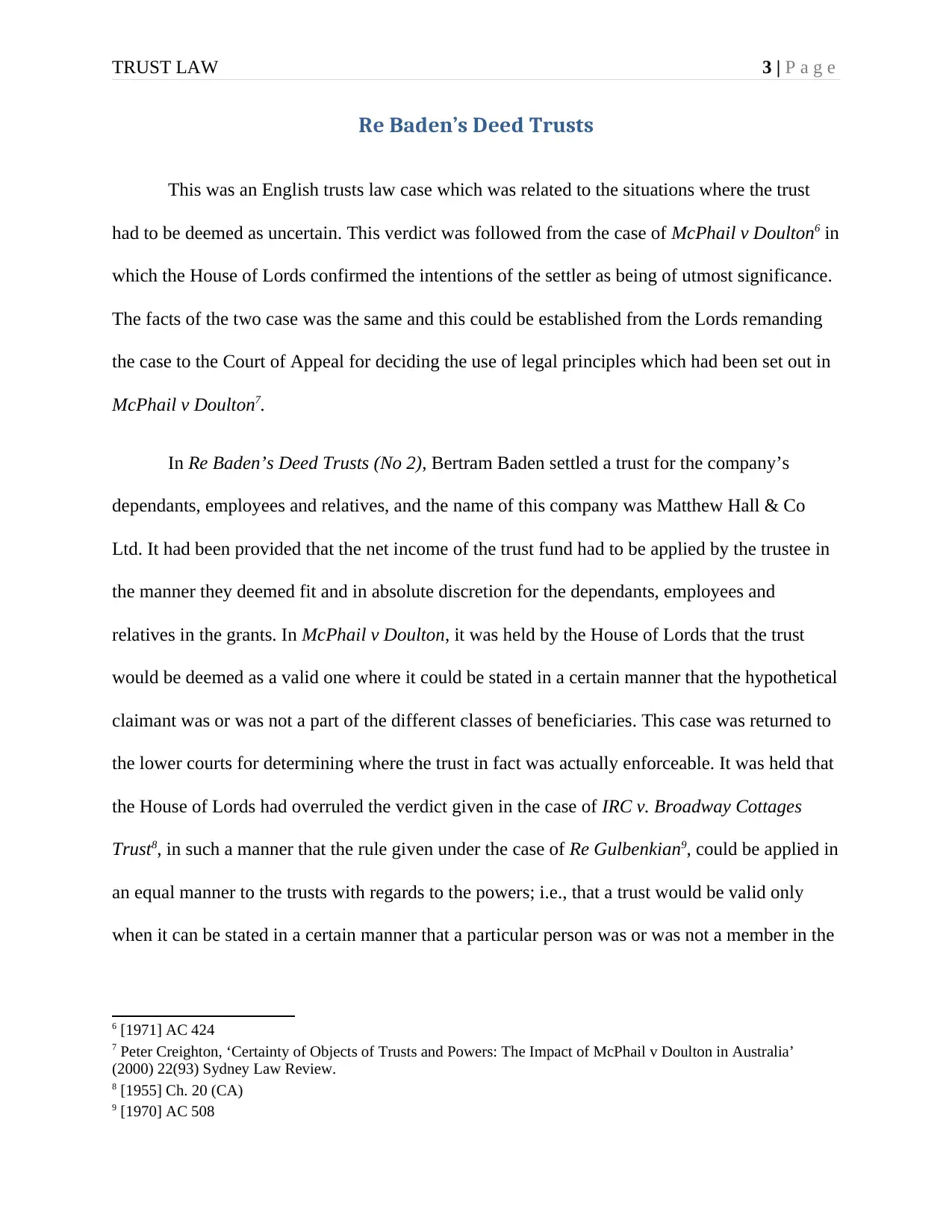
TRUST LAW 3 | P a g e
Re Baden’s Deed Trusts
This was an English trusts law case which was related to the situations where the trust
had to be deemed as uncertain. This verdict was followed from the case of McPhail v Doulton6 in
which the House of Lords confirmed the intentions of the settler as being of utmost significance.
The facts of the two case was the same and this could be established from the Lords remanding
the case to the Court of Appeal for deciding the use of legal principles which had been set out in
McPhail v Doulton7.
In Re Baden’s Deed Trusts (No 2), Bertram Baden settled a trust for the company’s
dependants, employees and relatives, and the name of this company was Matthew Hall & Co
Ltd. It had been provided that the net income of the trust fund had to be applied by the trustee in
the manner they deemed fit and in absolute discretion for the dependants, employees and
relatives in the grants. In McPhail v Doulton, it was held by the House of Lords that the trust
would be deemed as a valid one where it could be stated in a certain manner that the hypothetical
claimant was or was not a part of the different classes of beneficiaries. This case was returned to
the lower courts for determining where the trust in fact was actually enforceable. It was held that
the House of Lords had overruled the verdict given in the case of IRC v. Broadway Cottages
Trust8, in such a manner that the rule given under the case of Re Gulbenkian9, could be applied in
an equal manner to the trusts with regards to the powers; i.e., that a trust would be valid only
when it can be stated in a certain manner that a particular person was or was not a member in the
6 [1971] AC 424
7 Peter Creighton, ‘Certainty of Objects of Trusts and Powers: The Impact of McPhail v Doulton in Australia’
(2000) 22(93) Sydney Law Review.
8 [1955] Ch. 20 (CA)
9 [1970] AC 508
Re Baden’s Deed Trusts
This was an English trusts law case which was related to the situations where the trust
had to be deemed as uncertain. This verdict was followed from the case of McPhail v Doulton6 in
which the House of Lords confirmed the intentions of the settler as being of utmost significance.
The facts of the two case was the same and this could be established from the Lords remanding
the case to the Court of Appeal for deciding the use of legal principles which had been set out in
McPhail v Doulton7.
In Re Baden’s Deed Trusts (No 2), Bertram Baden settled a trust for the company’s
dependants, employees and relatives, and the name of this company was Matthew Hall & Co
Ltd. It had been provided that the net income of the trust fund had to be applied by the trustee in
the manner they deemed fit and in absolute discretion for the dependants, employees and
relatives in the grants. In McPhail v Doulton, it was held by the House of Lords that the trust
would be deemed as a valid one where it could be stated in a certain manner that the hypothetical
claimant was or was not a part of the different classes of beneficiaries. This case was returned to
the lower courts for determining where the trust in fact was actually enforceable. It was held that
the House of Lords had overruled the verdict given in the case of IRC v. Broadway Cottages
Trust8, in such a manner that the rule given under the case of Re Gulbenkian9, could be applied in
an equal manner to the trusts with regards to the powers; i.e., that a trust would be valid only
when it can be stated in a certain manner that a particular person was or was not a member in the
6 [1971] AC 424
7 Peter Creighton, ‘Certainty of Objects of Trusts and Powers: The Impact of McPhail v Doulton in Australia’
(2000) 22(93) Sydney Law Review.
8 [1955] Ch. 20 (CA)
9 [1970] AC 508
⊘ This is a preview!⊘
Do you want full access?
Subscribe today to unlock all pages.

Trusted by 1+ million students worldwide
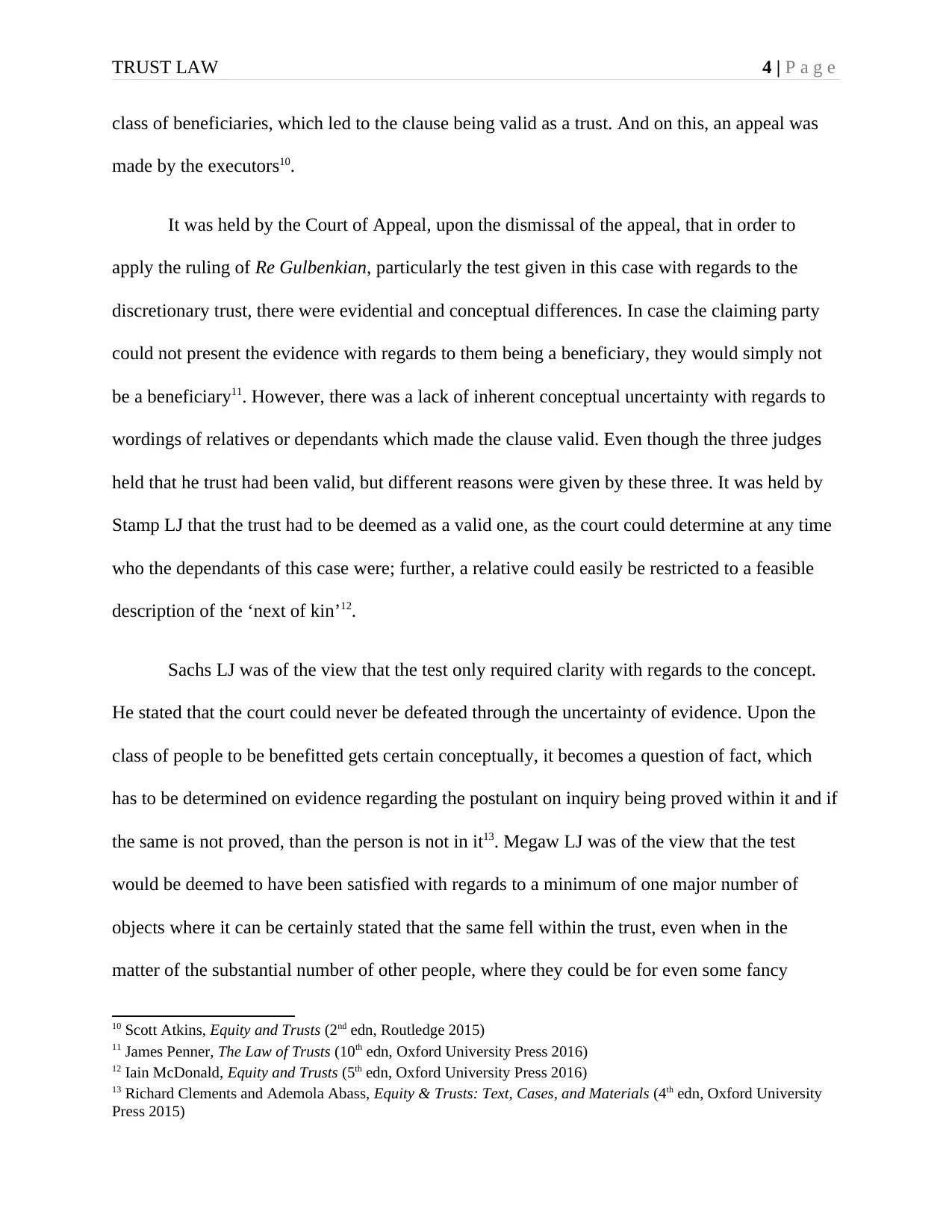
TRUST LAW 4 | P a g e
class of beneficiaries, which led to the clause being valid as a trust. And on this, an appeal was
made by the executors10.
It was held by the Court of Appeal, upon the dismissal of the appeal, that in order to
apply the ruling of Re Gulbenkian, particularly the test given in this case with regards to the
discretionary trust, there were evidential and conceptual differences. In case the claiming party
could not present the evidence with regards to them being a beneficiary, they would simply not
be a beneficiary11. However, there was a lack of inherent conceptual uncertainty with regards to
wordings of relatives or dependants which made the clause valid. Even though the three judges
held that he trust had been valid, but different reasons were given by these three. It was held by
Stamp LJ that the trust had to be deemed as a valid one, as the court could determine at any time
who the dependants of this case were; further, a relative could easily be restricted to a feasible
description of the ‘next of kin’12.
Sachs LJ was of the view that the test only required clarity with regards to the concept.
He stated that the court could never be defeated through the uncertainty of evidence. Upon the
class of people to be benefitted gets certain conceptually, it becomes a question of fact, which
has to be determined on evidence regarding the postulant on inquiry being proved within it and if
the same is not proved, than the person is not in it13. Megaw LJ was of the view that the test
would be deemed to have been satisfied with regards to a minimum of one major number of
objects where it can be certainly stated that the same fell within the trust, even when in the
matter of the substantial number of other people, where they could be for even some fancy
10 Scott Atkins, Equity and Trusts (2nd edn, Routledge 2015)
11 James Penner, The Law of Trusts (10th edn, Oxford University Press 2016)
12 Iain McDonald, Equity and Trusts (5th edn, Oxford University Press 2016)
13 Richard Clements and Ademola Abass, Equity & Trusts: Text, Cases, and Materials (4th edn, Oxford University
Press 2015)
class of beneficiaries, which led to the clause being valid as a trust. And on this, an appeal was
made by the executors10.
It was held by the Court of Appeal, upon the dismissal of the appeal, that in order to
apply the ruling of Re Gulbenkian, particularly the test given in this case with regards to the
discretionary trust, there were evidential and conceptual differences. In case the claiming party
could not present the evidence with regards to them being a beneficiary, they would simply not
be a beneficiary11. However, there was a lack of inherent conceptual uncertainty with regards to
wordings of relatives or dependants which made the clause valid. Even though the three judges
held that he trust had been valid, but different reasons were given by these three. It was held by
Stamp LJ that the trust had to be deemed as a valid one, as the court could determine at any time
who the dependants of this case were; further, a relative could easily be restricted to a feasible
description of the ‘next of kin’12.
Sachs LJ was of the view that the test only required clarity with regards to the concept.
He stated that the court could never be defeated through the uncertainty of evidence. Upon the
class of people to be benefitted gets certain conceptually, it becomes a question of fact, which
has to be determined on evidence regarding the postulant on inquiry being proved within it and if
the same is not proved, than the person is not in it13. Megaw LJ was of the view that the test
would be deemed to have been satisfied with regards to a minimum of one major number of
objects where it can be certainly stated that the same fell within the trust, even when in the
matter of the substantial number of other people, where they could be for even some fancy
10 Scott Atkins, Equity and Trusts (2nd edn, Routledge 2015)
11 James Penner, The Law of Trusts (10th edn, Oxford University Press 2016)
12 Iain McDonald, Equity and Trusts (5th edn, Oxford University Press 2016)
13 Richard Clements and Ademola Abass, Equity & Trusts: Text, Cases, and Materials (4th edn, Oxford University
Press 2015)
Paraphrase This Document
Need a fresh take? Get an instant paraphrase of this document with our AI Paraphraser
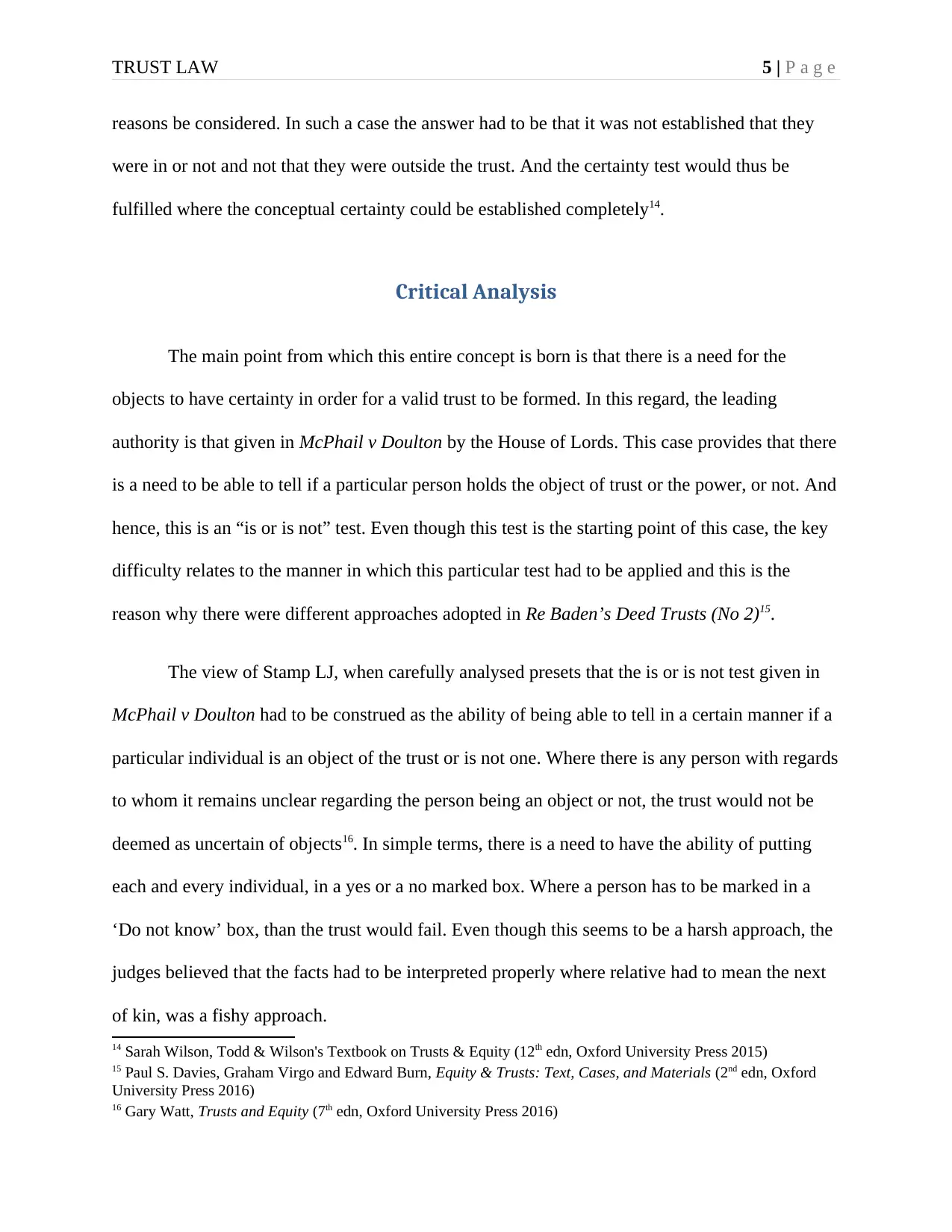
TRUST LAW 5 | P a g e
reasons be considered. In such a case the answer had to be that it was not established that they
were in or not and not that they were outside the trust. And the certainty test would thus be
fulfilled where the conceptual certainty could be established completely14.
Critical Analysis
The main point from which this entire concept is born is that there is a need for the
objects to have certainty in order for a valid trust to be formed. In this regard, the leading
authority is that given in McPhail v Doulton by the House of Lords. This case provides that there
is a need to be able to tell if a particular person holds the object of trust or the power, or not. And
hence, this is an “is or is not” test. Even though this test is the starting point of this case, the key
difficulty relates to the manner in which this particular test had to be applied and this is the
reason why there were different approaches adopted in Re Baden’s Deed Trusts (No 2)15.
The view of Stamp LJ, when carefully analysed presets that the is or is not test given in
McPhail v Doulton had to be construed as the ability of being able to tell in a certain manner if a
particular individual is an object of the trust or is not one. Where there is any person with regards
to whom it remains unclear regarding the person being an object or not, the trust would not be
deemed as uncertain of objects16. In simple terms, there is a need to have the ability of putting
each and every individual, in a yes or a no marked box. Where a person has to be marked in a
‘Do not know’ box, than the trust would fail. Even though this seems to be a harsh approach, the
judges believed that the facts had to be interpreted properly where relative had to mean the next
of kin, was a fishy approach.
14 Sarah Wilson, Todd & Wilson's Textbook on Trusts & Equity (12th edn, Oxford University Press 2015)
15 Paul S. Davies, Graham Virgo and Edward Burn, Equity & Trusts: Text, Cases, and Materials (2nd edn, Oxford
University Press 2016)
16 Gary Watt, Trusts and Equity (7th edn, Oxford University Press 2016)
reasons be considered. In such a case the answer had to be that it was not established that they
were in or not and not that they were outside the trust. And the certainty test would thus be
fulfilled where the conceptual certainty could be established completely14.
Critical Analysis
The main point from which this entire concept is born is that there is a need for the
objects to have certainty in order for a valid trust to be formed. In this regard, the leading
authority is that given in McPhail v Doulton by the House of Lords. This case provides that there
is a need to be able to tell if a particular person holds the object of trust or the power, or not. And
hence, this is an “is or is not” test. Even though this test is the starting point of this case, the key
difficulty relates to the manner in which this particular test had to be applied and this is the
reason why there were different approaches adopted in Re Baden’s Deed Trusts (No 2)15.
The view of Stamp LJ, when carefully analysed presets that the is or is not test given in
McPhail v Doulton had to be construed as the ability of being able to tell in a certain manner if a
particular individual is an object of the trust or is not one. Where there is any person with regards
to whom it remains unclear regarding the person being an object or not, the trust would not be
deemed as uncertain of objects16. In simple terms, there is a need to have the ability of putting
each and every individual, in a yes or a no marked box. Where a person has to be marked in a
‘Do not know’ box, than the trust would fail. Even though this seems to be a harsh approach, the
judges believed that the facts had to be interpreted properly where relative had to mean the next
of kin, was a fishy approach.
14 Sarah Wilson, Todd & Wilson's Textbook on Trusts & Equity (12th edn, Oxford University Press 2015)
15 Paul S. Davies, Graham Virgo and Edward Burn, Equity & Trusts: Text, Cases, and Materials (2nd edn, Oxford
University Press 2016)
16 Gary Watt, Trusts and Equity (7th edn, Oxford University Press 2016)
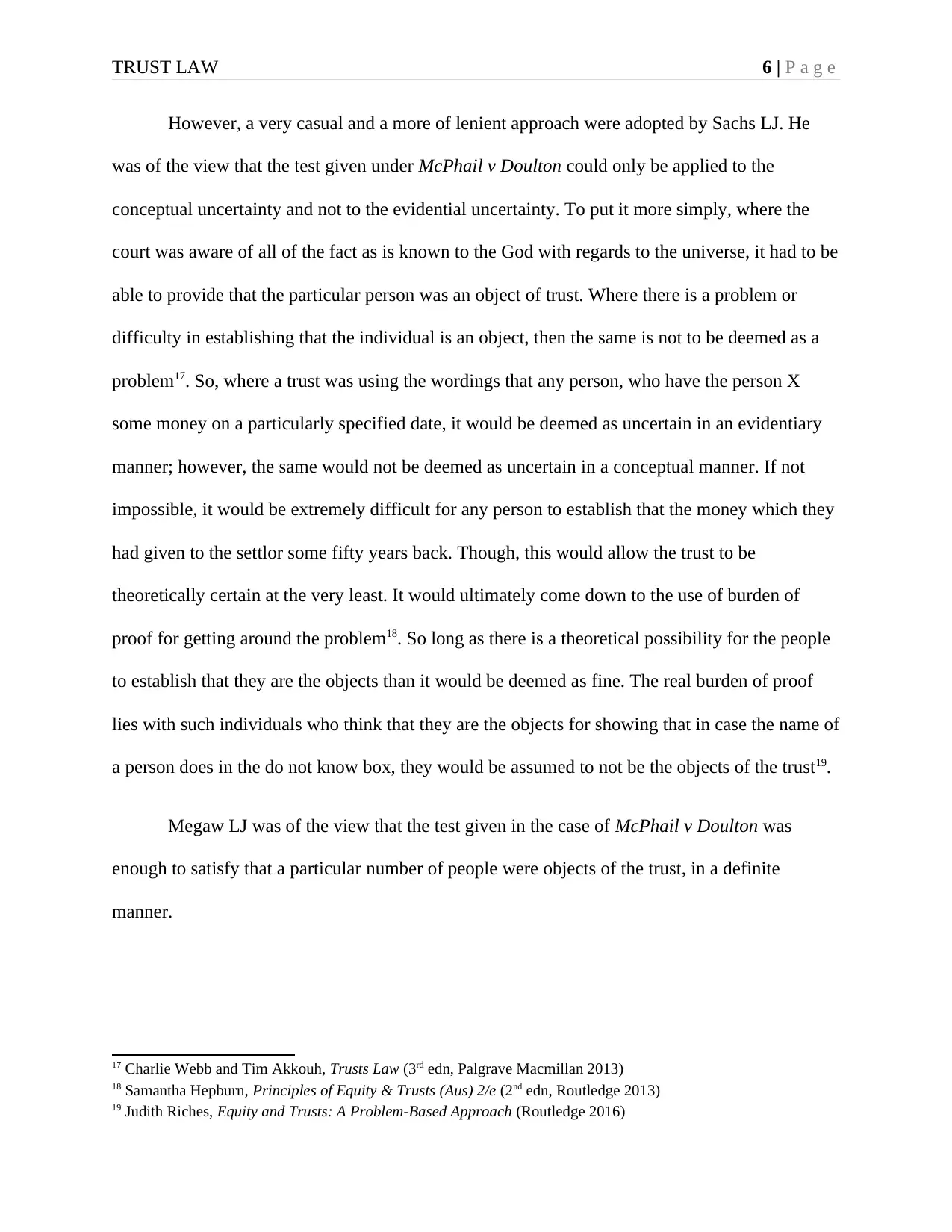
TRUST LAW 6 | P a g e
However, a very casual and a more of lenient approach were adopted by Sachs LJ. He
was of the view that the test given under McPhail v Doulton could only be applied to the
conceptual uncertainty and not to the evidential uncertainty. To put it more simply, where the
court was aware of all of the fact as is known to the God with regards to the universe, it had to be
able to provide that the particular person was an object of trust. Where there is a problem or
difficulty in establishing that the individual is an object, then the same is not to be deemed as a
problem17. So, where a trust was using the wordings that any person, who have the person X
some money on a particularly specified date, it would be deemed as uncertain in an evidentiary
manner; however, the same would not be deemed as uncertain in a conceptual manner. If not
impossible, it would be extremely difficult for any person to establish that the money which they
had given to the settlor some fifty years back. Though, this would allow the trust to be
theoretically certain at the very least. It would ultimately come down to the use of burden of
proof for getting around the problem18. So long as there is a theoretical possibility for the people
to establish that they are the objects than it would be deemed as fine. The real burden of proof
lies with such individuals who think that they are the objects for showing that in case the name of
a person does in the do not know box, they would be assumed to not be the objects of the trust19.
Megaw LJ was of the view that the test given in the case of McPhail v Doulton was
enough to satisfy that a particular number of people were objects of the trust, in a definite
manner.
17 Charlie Webb and Tim Akkouh, Trusts Law (3rd edn, Palgrave Macmillan 2013)
18 Samantha Hepburn, Principles of Equity & Trusts (Aus) 2/e (2nd edn, Routledge 2013)
19 Judith Riches, Equity and Trusts: A Problem-Based Approach (Routledge 2016)
However, a very casual and a more of lenient approach were adopted by Sachs LJ. He
was of the view that the test given under McPhail v Doulton could only be applied to the
conceptual uncertainty and not to the evidential uncertainty. To put it more simply, where the
court was aware of all of the fact as is known to the God with regards to the universe, it had to be
able to provide that the particular person was an object of trust. Where there is a problem or
difficulty in establishing that the individual is an object, then the same is not to be deemed as a
problem17. So, where a trust was using the wordings that any person, who have the person X
some money on a particularly specified date, it would be deemed as uncertain in an evidentiary
manner; however, the same would not be deemed as uncertain in a conceptual manner. If not
impossible, it would be extremely difficult for any person to establish that the money which they
had given to the settlor some fifty years back. Though, this would allow the trust to be
theoretically certain at the very least. It would ultimately come down to the use of burden of
proof for getting around the problem18. So long as there is a theoretical possibility for the people
to establish that they are the objects than it would be deemed as fine. The real burden of proof
lies with such individuals who think that they are the objects for showing that in case the name of
a person does in the do not know box, they would be assumed to not be the objects of the trust19.
Megaw LJ was of the view that the test given in the case of McPhail v Doulton was
enough to satisfy that a particular number of people were objects of the trust, in a definite
manner.
17 Charlie Webb and Tim Akkouh, Trusts Law (3rd edn, Palgrave Macmillan 2013)
18 Samantha Hepburn, Principles of Equity & Trusts (Aus) 2/e (2nd edn, Routledge 2013)
19 Judith Riches, Equity and Trusts: A Problem-Based Approach (Routledge 2016)
⊘ This is a preview!⊘
Do you want full access?
Subscribe today to unlock all pages.

Trusted by 1+ million students worldwide
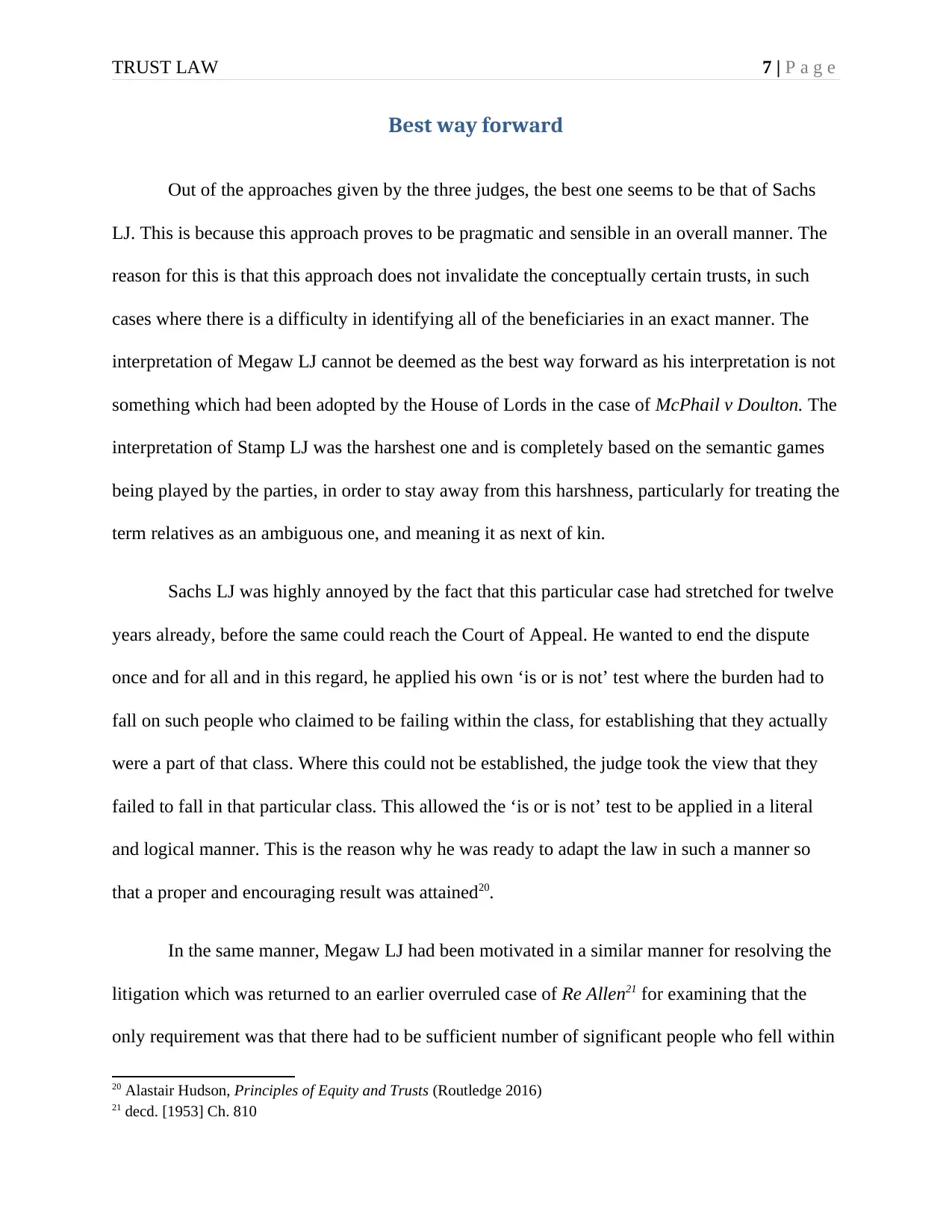
TRUST LAW 7 | P a g e
Best way forward
Out of the approaches given by the three judges, the best one seems to be that of Sachs
LJ. This is because this approach proves to be pragmatic and sensible in an overall manner. The
reason for this is that this approach does not invalidate the conceptually certain trusts, in such
cases where there is a difficulty in identifying all of the beneficiaries in an exact manner. The
interpretation of Megaw LJ cannot be deemed as the best way forward as his interpretation is not
something which had been adopted by the House of Lords in the case of McPhail v Doulton. The
interpretation of Stamp LJ was the harshest one and is completely based on the semantic games
being played by the parties, in order to stay away from this harshness, particularly for treating the
term relatives as an ambiguous one, and meaning it as next of kin.
Sachs LJ was highly annoyed by the fact that this particular case had stretched for twelve
years already, before the same could reach the Court of Appeal. He wanted to end the dispute
once and for all and in this regard, he applied his own ‘is or is not’ test where the burden had to
fall on such people who claimed to be failing within the class, for establishing that they actually
were a part of that class. Where this could not be established, the judge took the view that they
failed to fall in that particular class. This allowed the ‘is or is not’ test to be applied in a literal
and logical manner. This is the reason why he was ready to adapt the law in such a manner so
that a proper and encouraging result was attained20.
In the same manner, Megaw LJ had been motivated in a similar manner for resolving the
litigation which was returned to an earlier overruled case of Re Allen21 for examining that the
only requirement was that there had to be sufficient number of significant people who fell within
20 Alastair Hudson, Principles of Equity and Trusts (Routledge 2016)
21 decd. [1953] Ch. 810
Best way forward
Out of the approaches given by the three judges, the best one seems to be that of Sachs
LJ. This is because this approach proves to be pragmatic and sensible in an overall manner. The
reason for this is that this approach does not invalidate the conceptually certain trusts, in such
cases where there is a difficulty in identifying all of the beneficiaries in an exact manner. The
interpretation of Megaw LJ cannot be deemed as the best way forward as his interpretation is not
something which had been adopted by the House of Lords in the case of McPhail v Doulton. The
interpretation of Stamp LJ was the harshest one and is completely based on the semantic games
being played by the parties, in order to stay away from this harshness, particularly for treating the
term relatives as an ambiguous one, and meaning it as next of kin.
Sachs LJ was highly annoyed by the fact that this particular case had stretched for twelve
years already, before the same could reach the Court of Appeal. He wanted to end the dispute
once and for all and in this regard, he applied his own ‘is or is not’ test where the burden had to
fall on such people who claimed to be failing within the class, for establishing that they actually
were a part of that class. Where this could not be established, the judge took the view that they
failed to fall in that particular class. This allowed the ‘is or is not’ test to be applied in a literal
and logical manner. This is the reason why he was ready to adapt the law in such a manner so
that a proper and encouraging result was attained20.
In the same manner, Megaw LJ had been motivated in a similar manner for resolving the
litigation which was returned to an earlier overruled case of Re Allen21 for examining that the
only requirement was that there had to be sufficient number of significant people who fell within
20 Alastair Hudson, Principles of Equity and Trusts (Routledge 2016)
21 decd. [1953] Ch. 810
Paraphrase This Document
Need a fresh take? Get an instant paraphrase of this document with our AI Paraphraser
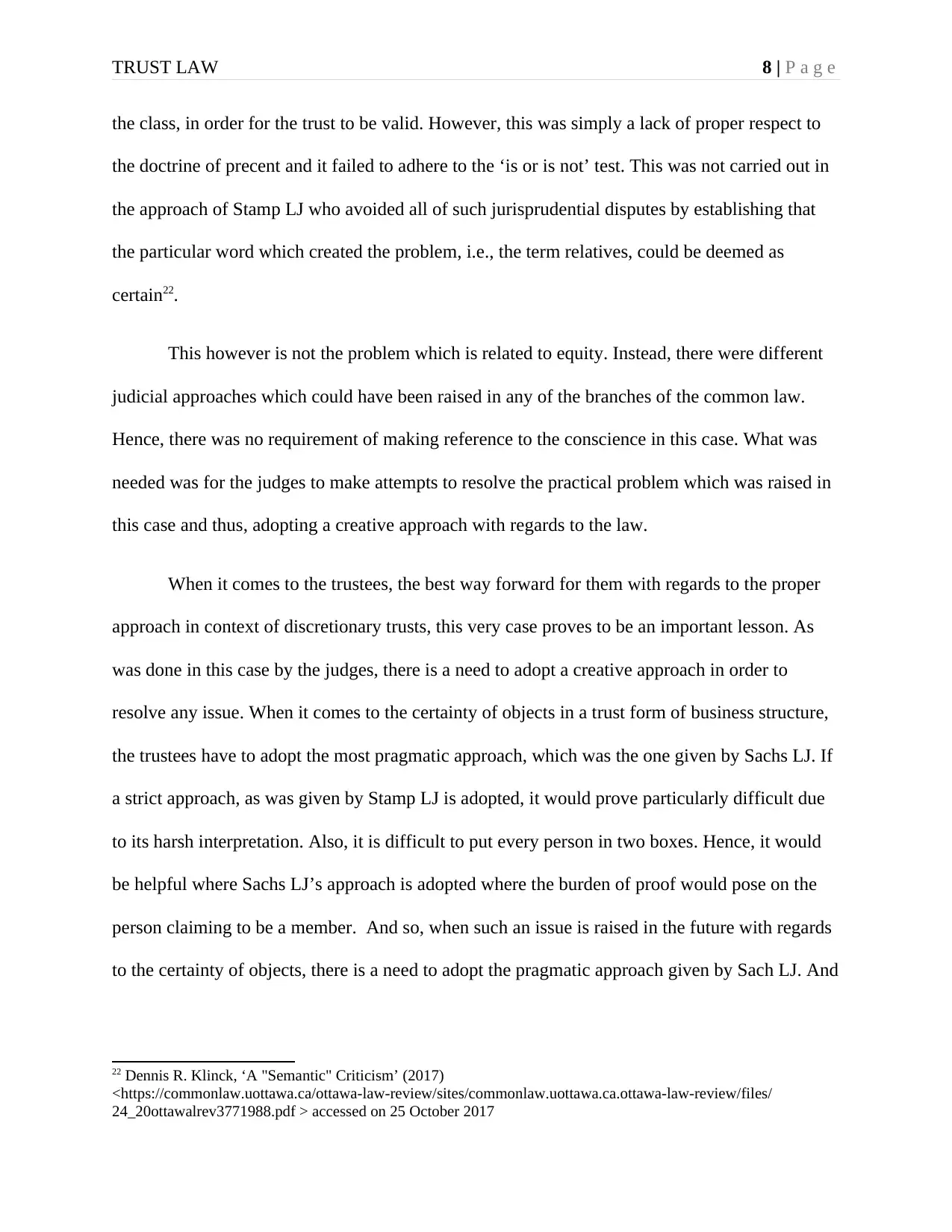
TRUST LAW 8 | P a g e
the class, in order for the trust to be valid. However, this was simply a lack of proper respect to
the doctrine of precent and it failed to adhere to the ‘is or is not’ test. This was not carried out in
the approach of Stamp LJ who avoided all of such jurisprudential disputes by establishing that
the particular word which created the problem, i.e., the term relatives, could be deemed as
certain22.
This however is not the problem which is related to equity. Instead, there were different
judicial approaches which could have been raised in any of the branches of the common law.
Hence, there was no requirement of making reference to the conscience in this case. What was
needed was for the judges to make attempts to resolve the practical problem which was raised in
this case and thus, adopting a creative approach with regards to the law.
When it comes to the trustees, the best way forward for them with regards to the proper
approach in context of discretionary trusts, this very case proves to be an important lesson. As
was done in this case by the judges, there is a need to adopt a creative approach in order to
resolve any issue. When it comes to the certainty of objects in a trust form of business structure,
the trustees have to adopt the most pragmatic approach, which was the one given by Sachs LJ. If
a strict approach, as was given by Stamp LJ is adopted, it would prove particularly difficult due
to its harsh interpretation. Also, it is difficult to put every person in two boxes. Hence, it would
be helpful where Sachs LJ’s approach is adopted where the burden of proof would pose on the
person claiming to be a member. And so, when such an issue is raised in the future with regards
to the certainty of objects, there is a need to adopt the pragmatic approach given by Sach LJ. And
22 Dennis R. Klinck, ‘A "Semantic" Criticism’ (2017)
<https://commonlaw.uottawa.ca/ottawa-law-review/sites/commonlaw.uottawa.ca.ottawa-law-review/files/
24_20ottawalrev3771988.pdf > accessed on 25 October 2017
the class, in order for the trust to be valid. However, this was simply a lack of proper respect to
the doctrine of precent and it failed to adhere to the ‘is or is not’ test. This was not carried out in
the approach of Stamp LJ who avoided all of such jurisprudential disputes by establishing that
the particular word which created the problem, i.e., the term relatives, could be deemed as
certain22.
This however is not the problem which is related to equity. Instead, there were different
judicial approaches which could have been raised in any of the branches of the common law.
Hence, there was no requirement of making reference to the conscience in this case. What was
needed was for the judges to make attempts to resolve the practical problem which was raised in
this case and thus, adopting a creative approach with regards to the law.
When it comes to the trustees, the best way forward for them with regards to the proper
approach in context of discretionary trusts, this very case proves to be an important lesson. As
was done in this case by the judges, there is a need to adopt a creative approach in order to
resolve any issue. When it comes to the certainty of objects in a trust form of business structure,
the trustees have to adopt the most pragmatic approach, which was the one given by Sachs LJ. If
a strict approach, as was given by Stamp LJ is adopted, it would prove particularly difficult due
to its harsh interpretation. Also, it is difficult to put every person in two boxes. Hence, it would
be helpful where Sachs LJ’s approach is adopted where the burden of proof would pose on the
person claiming to be a member. And so, when such an issue is raised in the future with regards
to the certainty of objects, there is a need to adopt the pragmatic approach given by Sach LJ. And
22 Dennis R. Klinck, ‘A "Semantic" Criticism’ (2017)
<https://commonlaw.uottawa.ca/ottawa-law-review/sites/commonlaw.uottawa.ca.ottawa-law-review/files/
24_20ottawalrev3771988.pdf > accessed on 25 October 2017
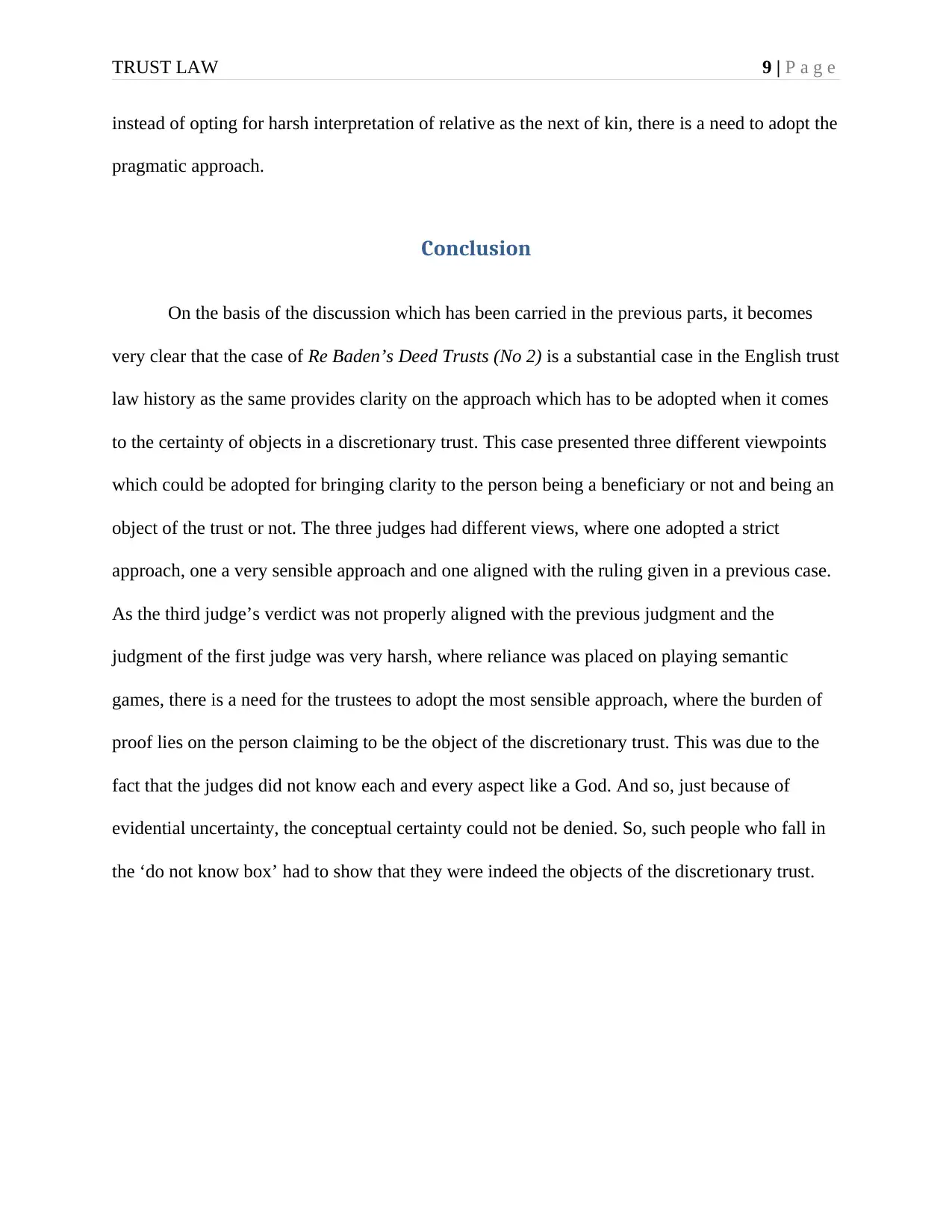
TRUST LAW 9 | P a g e
instead of opting for harsh interpretation of relative as the next of kin, there is a need to adopt the
pragmatic approach.
Conclusion
On the basis of the discussion which has been carried in the previous parts, it becomes
very clear that the case of Re Baden’s Deed Trusts (No 2) is a substantial case in the English trust
law history as the same provides clarity on the approach which has to be adopted when it comes
to the certainty of objects in a discretionary trust. This case presented three different viewpoints
which could be adopted for bringing clarity to the person being a beneficiary or not and being an
object of the trust or not. The three judges had different views, where one adopted a strict
approach, one a very sensible approach and one aligned with the ruling given in a previous case.
As the third judge’s verdict was not properly aligned with the previous judgment and the
judgment of the first judge was very harsh, where reliance was placed on playing semantic
games, there is a need for the trustees to adopt the most sensible approach, where the burden of
proof lies on the person claiming to be the object of the discretionary trust. This was due to the
fact that the judges did not know each and every aspect like a God. And so, just because of
evidential uncertainty, the conceptual certainty could not be denied. So, such people who fall in
the ‘do not know box’ had to show that they were indeed the objects of the discretionary trust.
instead of opting for harsh interpretation of relative as the next of kin, there is a need to adopt the
pragmatic approach.
Conclusion
On the basis of the discussion which has been carried in the previous parts, it becomes
very clear that the case of Re Baden’s Deed Trusts (No 2) is a substantial case in the English trust
law history as the same provides clarity on the approach which has to be adopted when it comes
to the certainty of objects in a discretionary trust. This case presented three different viewpoints
which could be adopted for bringing clarity to the person being a beneficiary or not and being an
object of the trust or not. The three judges had different views, where one adopted a strict
approach, one a very sensible approach and one aligned with the ruling given in a previous case.
As the third judge’s verdict was not properly aligned with the previous judgment and the
judgment of the first judge was very harsh, where reliance was placed on playing semantic
games, there is a need for the trustees to adopt the most sensible approach, where the burden of
proof lies on the person claiming to be the object of the discretionary trust. This was due to the
fact that the judges did not know each and every aspect like a God. And so, just because of
evidential uncertainty, the conceptual certainty could not be denied. So, such people who fall in
the ‘do not know box’ had to show that they were indeed the objects of the discretionary trust.
⊘ This is a preview!⊘
Do you want full access?
Subscribe today to unlock all pages.

Trusted by 1+ million students worldwide
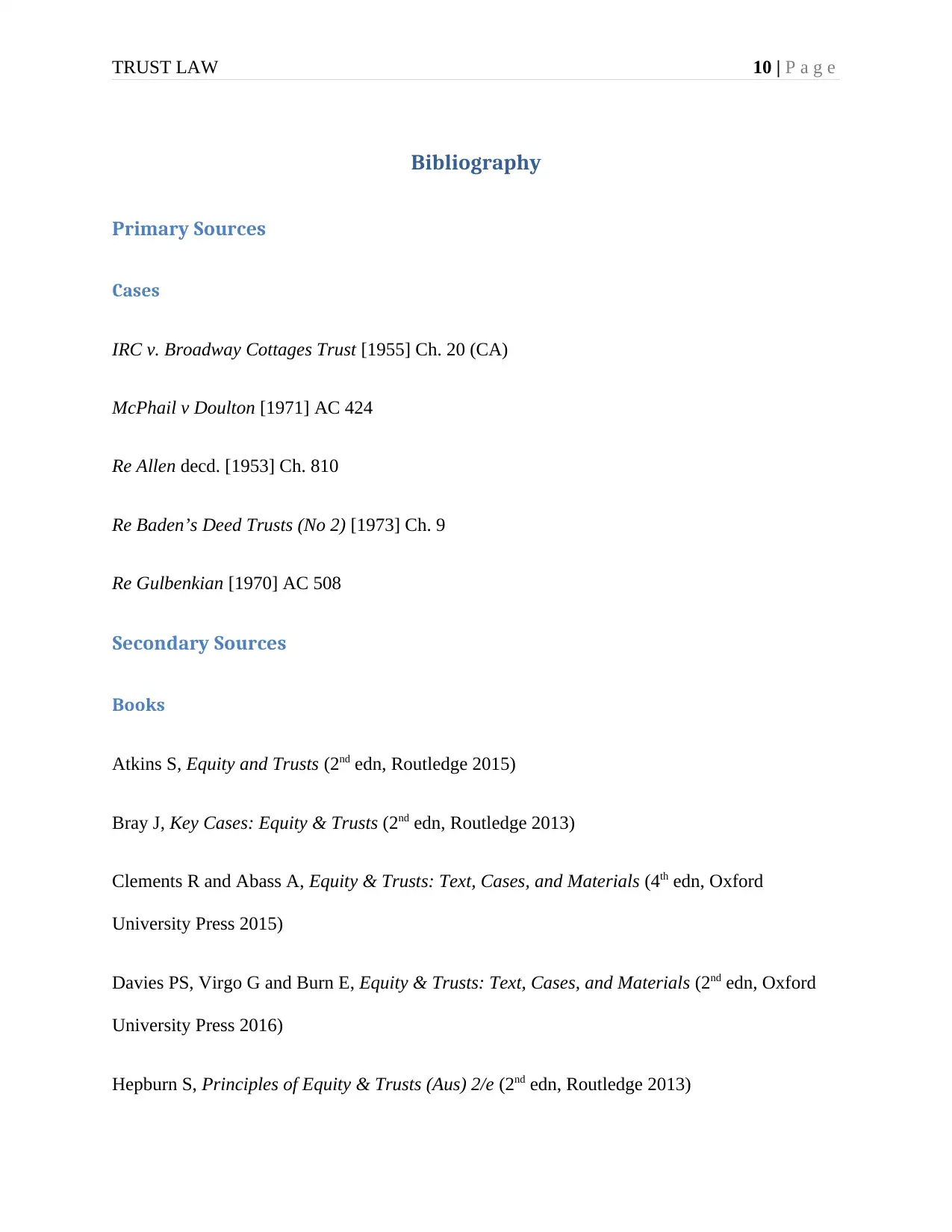
TRUST LAW 10 | P a g e
Bibliography
Primary Sources
Cases
IRC v. Broadway Cottages Trust [1955] Ch. 20 (CA)
McPhail v Doulton [1971] AC 424
Re Allen decd. [1953] Ch. 810
Re Baden’s Deed Trusts (No 2) [1973] Ch. 9
Re Gulbenkian [1970] AC 508
Secondary Sources
Books
Atkins S, Equity and Trusts (2nd edn, Routledge 2015)
Bray J, Key Cases: Equity & Trusts (2nd edn, Routledge 2013)
Clements R and Abass A, Equity & Trusts: Text, Cases, and Materials (4th edn, Oxford
University Press 2015)
Davies PS, Virgo G and Burn E, Equity & Trusts: Text, Cases, and Materials (2nd edn, Oxford
University Press 2016)
Hepburn S, Principles of Equity & Trusts (Aus) 2/e (2nd edn, Routledge 2013)
Bibliography
Primary Sources
Cases
IRC v. Broadway Cottages Trust [1955] Ch. 20 (CA)
McPhail v Doulton [1971] AC 424
Re Allen decd. [1953] Ch. 810
Re Baden’s Deed Trusts (No 2) [1973] Ch. 9
Re Gulbenkian [1970] AC 508
Secondary Sources
Books
Atkins S, Equity and Trusts (2nd edn, Routledge 2015)
Bray J, Key Cases: Equity & Trusts (2nd edn, Routledge 2013)
Clements R and Abass A, Equity & Trusts: Text, Cases, and Materials (4th edn, Oxford
University Press 2015)
Davies PS, Virgo G and Burn E, Equity & Trusts: Text, Cases, and Materials (2nd edn, Oxford
University Press 2016)
Hepburn S, Principles of Equity & Trusts (Aus) 2/e (2nd edn, Routledge 2013)
Paraphrase This Document
Need a fresh take? Get an instant paraphrase of this document with our AI Paraphraser
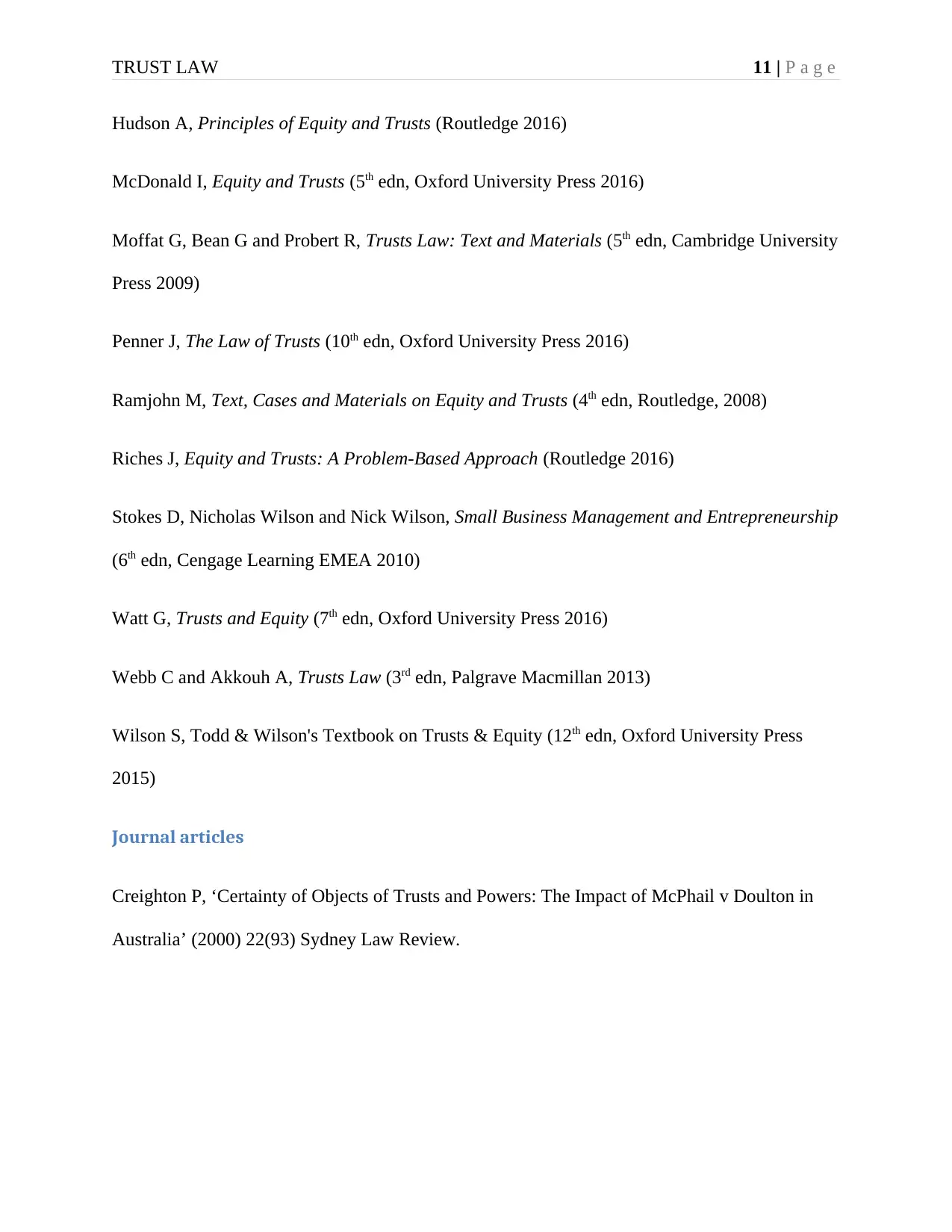
TRUST LAW 11 | P a g e
Hudson A, Principles of Equity and Trusts (Routledge 2016)
McDonald I, Equity and Trusts (5th edn, Oxford University Press 2016)
Moffat G, Bean G and Probert R, Trusts Law: Text and Materials (5th edn, Cambridge University
Press 2009)
Penner J, The Law of Trusts (10th edn, Oxford University Press 2016)
Ramjohn M, Text, Cases and Materials on Equity and Trusts (4th edn, Routledge, 2008)
Riches J, Equity and Trusts: A Problem-Based Approach (Routledge 2016)
Stokes D, Nicholas Wilson and Nick Wilson, Small Business Management and Entrepreneurship
(6th edn, Cengage Learning EMEA 2010)
Watt G, Trusts and Equity (7th edn, Oxford University Press 2016)
Webb C and Akkouh A, Trusts Law (3rd edn, Palgrave Macmillan 2013)
Wilson S, Todd & Wilson's Textbook on Trusts & Equity (12th edn, Oxford University Press
2015)
Journal articles
Creighton P, ‘Certainty of Objects of Trusts and Powers: The Impact of McPhail v Doulton in
Australia’ (2000) 22(93) Sydney Law Review.
Hudson A, Principles of Equity and Trusts (Routledge 2016)
McDonald I, Equity and Trusts (5th edn, Oxford University Press 2016)
Moffat G, Bean G and Probert R, Trusts Law: Text and Materials (5th edn, Cambridge University
Press 2009)
Penner J, The Law of Trusts (10th edn, Oxford University Press 2016)
Ramjohn M, Text, Cases and Materials on Equity and Trusts (4th edn, Routledge, 2008)
Riches J, Equity and Trusts: A Problem-Based Approach (Routledge 2016)
Stokes D, Nicholas Wilson and Nick Wilson, Small Business Management and Entrepreneurship
(6th edn, Cengage Learning EMEA 2010)
Watt G, Trusts and Equity (7th edn, Oxford University Press 2016)
Webb C and Akkouh A, Trusts Law (3rd edn, Palgrave Macmillan 2013)
Wilson S, Todd & Wilson's Textbook on Trusts & Equity (12th edn, Oxford University Press
2015)
Journal articles
Creighton P, ‘Certainty of Objects of Trusts and Powers: The Impact of McPhail v Doulton in
Australia’ (2000) 22(93) Sydney Law Review.

TRUST LAW 12 | P a g e
Websites and blogs
Klinck DR, ‘A "Semantic" Criticism’ (2017) <https://commonlaw.uottawa.ca/ottawa-law-
review/sites/commonlaw.uottawa.ca.ottawa-law-review/files/24_20ottawalrev3771988.pdf >
accessed on 25 October 2017
Websites and blogs
Klinck DR, ‘A "Semantic" Criticism’ (2017) <https://commonlaw.uottawa.ca/ottawa-law-
review/sites/commonlaw.uottawa.ca.ottawa-law-review/files/24_20ottawalrev3771988.pdf >
accessed on 25 October 2017
⊘ This is a preview!⊘
Do you want full access?
Subscribe today to unlock all pages.

Trusted by 1+ million students worldwide
1 out of 12
Related Documents
Your All-in-One AI-Powered Toolkit for Academic Success.
+13062052269
info@desklib.com
Available 24*7 on WhatsApp / Email
![[object Object]](/_next/static/media/star-bottom.7253800d.svg)
Unlock your academic potential
Copyright © 2020–2025 A2Z Services. All Rights Reserved. Developed and managed by ZUCOL.





